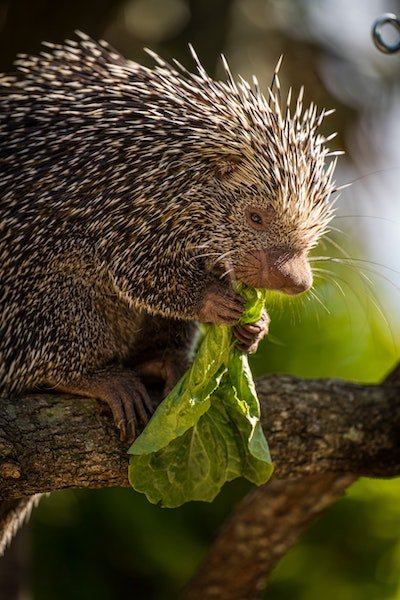A Prickly Predicament
J. Glover, CC BY-SA 2.5, via Wikimedia Commons
Erethizontidae
by Inspector Barry Mins on February 28, 2023Hey kids, welcome back to our series on the mysteries of created kinds. Last week, we met a colorful group of newts that live on the west coast of the United States. This week, we move from the left coast to the whole of the Americas. Watch your step—if you stand on one of these mammals, you will regret it.

These rodents love to munch on leaves, with one species’ diet consisting of up to 75% leaves.1 In that same species, the diet is highly specialized, largely made up of just four species of plants.2 In some species, the dietary nitrogen required is extracted from food very efficiently, allowing them to eat nitrogen-poor foods.3 They can also adjust their metabolic rate depending on the conditions, meaning they can get by eating less when food is scarce in winter.4
Members of this kind can be largely nocturnal and are relatively slow-moving.5 In theory, this kind should be easy prey for wolves, pumas, jaguars, coyotes, and other large predators. However, these remarkable rodents have some ways to protect themselves. They produce a noxious warning odor that tells predators they are dangerous.6 If a predator is hungry or foolish enough to ignore the warning, the next line of defense kicks in. These rodents come armed with quills, which serve as a form of repellant. If a predator touches them, the quills will bury themselves in the predator’s skin, becoming almost impossible to remove. In a study tracking the deaths of cougars, nearly ten percent were killed as a result of trying to prey on this rodent.7
Has anyone figured it out yet? This week’s kind is the Erethizontidae—the porcupine kind. These adorable rodents are not to be cuddled. Some species have up to 30,000 quills! Stay tuned for next week when we look for some lovely songbirds found on every continent, sometimes even Antarctica.

Porcupine Holding Leaf
Photo by ALTEREDSNAPS from Pexels
Try out this fun word search!
Clue
Your clue for the week is:
These small songbirds are known for their forked tails and impressive flying skills.
Ask a Question
Have you ever had a question about created kinds but didn’t know who to ask? Have you ever wanted to learn more about your favorite kind? Well, now you can! You can ask me, Inspector Barry Mins, a question! Have your parents help you fill out this form, and you might get your question answered in my column! If you have any questions about created kinds, feel free to send them my way!
Footnotes
- A. G. Chiarello, R. B. De Souto Lima, and P. A. Oliveira, “Diet of the thin-spined porcupine (Chaetomys subspinosus), an Atlantic forest endemic threatened with extinction in southeastern Brazil,” Mammalian Biology 75, no. 6 (2010): 538–546.
- G. A. F. Gine, J. M. B. Duarte, and D. Faria, “Feeding ecology of a selective folivore, the thin-spined porcupine (Chaetomys subspinosus) in the Atlantic forest,” Journal of Mammalogy 91, no. 4 (2010): 931–941.
- F. Fournier, and D. W. Thomas, “Nitrogen and energy requirements of the North American porcupine (Erethizon dosratum),” Physiological Zoology 70, no. 6 (1997): 616–620.
- J. A. Coltrane and P. S. Barboza, “Winter as a nutritional bottleneck for North American porcupines (Erethizon dorsatum),” Journal of Comparative Physiology B 180, (2010): 905–918.
- A. G. Chiarello, M. Passamani and M. Zortea, “Field observations on the thin-spined porcupine Chaetomys subspinosus (Rodentia; Echimyidae),” Mammalia 61, no. 1 (1997): 29–36.
- G. Li, U. Roze, and D. C. Locke, “Warning odor of the North American porcupine (Erethizon dorsatum),” Journal of Chemical Ecology 23, no. 12 (1997): 2737–2754.
- L. M. Elbroch, R. Hoodesteijn and H. Quigley, “Cougars (Puma concolor) killed by North American porcupines (Erethizon dorsatum),” The Canadian Field Naturalist 130, (2016): 53–55.
- © 2024 Answers in Genesis
- Privacy Policy
- Contact
- About
